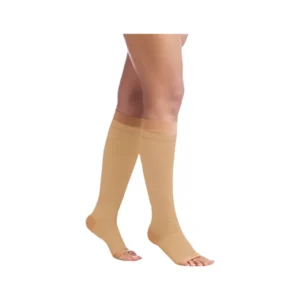Description
How DVT Pumps Work
DVT pumps use intermittent pneumatic compression to mimic the natural muscle contractions that help blood flow through the veins. The device consists of:
- Inflatable Sleeves: Wrapped around the legs (calf, thigh, or foot).
- Air Pump Unit: Delivers controlled air pressure to the sleeves.
- Tubing: Connects the sleeves to the pump.
The sleeves inflate and deflate in a rhythmic pattern, applying pressure to the veins and promoting blood flow back to the heart. This helps minimize the risk of blood accumulation and clot development.
Key Features of DVT Pumps
- Adjustable Pressure Settings: Customizable compression levels for patient comfort and effectiveness.
- Sequential Compression: Gradual pressure application from the foot or calf upward to mimic natural blood flow.
- Portable and Lightweight: Many models are designed for home use or travel.
- Battery or AC Power: Allows for continuous use, even during power outages.
- Safety Alarms: Alerts for improper sleeve placement, low battery, or device malfunction.
Types of DVT Pumps
- Calf Compression Devices:
- Sleeves cover the calf area.
- Ideal for patients with limited mobility or post-surgical recovery.
- Thigh-High Compression Devices:
- Sleeves extend from the foot to the thigh.
- Provides more comprehensive compression for high-risk patients.
Who Needs a DVT Pump?
- Post-Surgical Patients: After orthopedic, abdominal, or cardiac surgery.
- Immobile Patients: Bedridden individuals or those with limited mobility.
- Long-Haul Travelers: To prevent DVT during long flights or car rides.
- High-Risk Individuals: Patients with a history of DVT, obesity, or clotting disorders.
- Pregnant Women: Increased risk of DVT due to hormonal changes.
Benefits of DVT Pumps
- Prevents Blood Clots: Reduces the risk of DVT and pulmonary embolism.
- Improves Circulation: Enhances blood flow in the legs.
- Non-Invasive: No medications or surgery required.
- Easy to Use: Simple setup and operation for home or hospital use.
- Cost-Effective: Prevents costly complications like hospital readmissions.
How to Use a DVT Pump
- Position the Sleeves: Wrap the sleeves around the legs as instructed.
- Connect the Tubing: Attach the sleeves to the pump unit.
- Set the Pressure: Adjust the compression level as prescribed by a healthcare provider.
- Turn On the Device: Start the compression cycle and monitor for comfort.
Maintenance and Care
- Clean Sleeves: Wipe sleeves with a damp cloth.
- Inspect Tubing: Check for cracks or leaks regularly.
- Proper Storage: Store the device in a cool, dry location.
- Replace Parts: Follow manufacturer guidelines for replacing sleeves or tubing.
DVT pumps are essential medical devices for preventing blood clots in high-risk individuals, particularly after surgery or during periods of immobility. They are non-invasive, easy to use, and highly effective at improving circulation and reducing the risk of DVT. For mild cases, compression stockings may suffice, but for severe or post-surgical needs, a DVT pump is the gold standard. Always consult Healthcare Needs to determine the best option for your condition.



